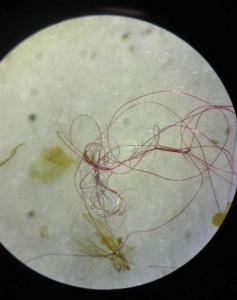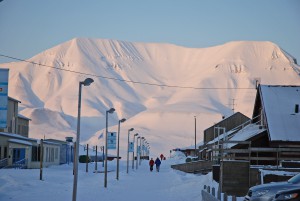
One of my favourite winter jackets is made of fleece. Unfortunately, that is bad. I learned that, when I updated my lecture about plastic pollution which I hold on ships. I once again realized, how often we contribute to the pollution and intoxication of our planet, without even being aware of it. The Alfred-Wegener-Institut for Polar- and Marine Research gave me some material, in which I found the following: With every washing of a fleece-sweater, about 1900 fibres are washed out. The fibres get into the wastewater, and many sewage plants cannot filter them. As a result, they become part of the micro plastic-problem. These particles enter our food chain. Either because a fish eats them, or because the softeners of the plastic go into the water, or both. There are many variations, how plastic finds his way back to us. Sure is only: It comes back.
A study in Spitsbergen has now shown, that Fleece-Sweaters are not at all a small part of the problem.
Longyearbyen is the main settlement in Spitsbergen, situated at 78° Nord. It is a harsh climate in this latitude, and therefore the main clothing there is sports clothing, even in offices. Windproof fabrics, functional underwear, synthetics, fleece – that is the clothing you see everywhere in Longyearbyen. Everything else is too cold or unfunctional.
 The Svalbardposten, the local newspaper of Longyearbyen, has reported last week, which effect the washing of this clothing has: Two scientists, Dorte Herzke from the Norwegian Institute for Air Research (NILU) and Jan H. Sundet, oceanographer at the Norwegian Institute of Marine Research (IMR) have monitored emissions and sediment samples from the seabed in Adventfjord. Longyearbyen with its 2000 inhabitants is located in Adventfjord.
The Svalbardposten, the local newspaper of Longyearbyen, has reported last week, which effect the washing of this clothing has: Two scientists, Dorte Herzke from the Norwegian Institute for Air Research (NILU) and Jan H. Sundet, oceanographer at the Norwegian Institute of Marine Research (IMR) have monitored emissions and sediment samples from the seabed in Adventfjord. Longyearbyen with its 2000 inhabitants is located in Adventfjord.
Result: Despite its location far away from the centers of civilization, we have already succeeded in polluting the ocean even up in Longyearbyen. The settlement´s wastewater contains large amounts of micro plastic, and the biggest part of it origins in outdoor clothing. “We are finding first and foremost filamentous plastic particles of different colors and types”, says Sundet. According to the scientists, every day more than 100 million particles of plastic are washed into the fjord. Households in Svalbard and in the Arctic are contributing to the discharge of plastic waste, and perhaps to a greater extent than we like to think about, continues Sundet in the Svalbardposten. The study, financed by the Svalbard Environmental Protection Fund, has started in summer 2015 and is not finished yet. The goal is to determine the amount of micro plastic entering the ocean due to the human presence.
But this is not yet the worst: Plastic alone already contains many substances, you do not want to have in your drinking water or on your plate. Softeners, many chemicals. But unfortunately, it does not remain with these. Microplastic has the tendency to absorb other contaminants. Studies have shown, that these small particles are like magnets to toxics that are solved in the water. The longer a piece of plastic stays in the water, the more toxic it becomes. When finally a fish eats the particle, it is feeding on a whole cocktail of toxics.
Who thinks, to make a good thing when buying a fleece jacket made out of PET bottles, is wrong. In reality he is only contributing to the thickening of our plastic soup in our oceans. A good text on that was published in the Volkskrant (in dutch), 5 of March. And in the river Danubia by now are swimming more plastic particles than fish larvae, visible in a short movie on german 3 sat.
So, all bad? No. The nice thing with the fleece problem is: We can do something about it, easily.
The study in Spitsbergen shows us once again: We think we are a happy bunch of nature loving people. We love being outdoors, we love the mountains, the snow, the clean air. Especially in Spitsbergen there might be many people with this self-concept. And the more we want to be outside, the better we need to be dressed. And the more toxics we produce. But, let us be honest: Very often, we exaggerate. Who does not know this irresistible buying reflex, when entering an outdoor shop? Who does not have too many sports clothes at home? And who does not want maybe just this one more new thing, and then new skis, and then . . . every year again?
 If we do love nature so much, we might have to be harder to ourselves, not only out in the field, but also in the shops. We should ask ourselves before every new purchase: Do I really need this? A third pair of pants, because pant number one is good for low temperatures and pant number two for spring, but I do not yet have a pant for temperatures from pus 5 to plus 10? Do we really need all that?
If we do love nature so much, we might have to be harder to ourselves, not only out in the field, but also in the shops. We should ask ourselves before every new purchase: Do I really need this? A third pair of pants, because pant number one is good for low temperatures and pant number two for spring, but I do not yet have a pant for temperatures from pus 5 to plus 10? Do we really need all that?
And if we do not want to buy less, maybe at least we should buy differently: I said good-bye to fleece. You can replace fleece and synthetic clothing easily with merino wool, in winter same as in summer. Even when crossing Greenland, I had only the wind proof outer shell made of plastic, and hopefully soon there will be a replacement for that as well.
So, it is not difficult to resolve the microfibre problem and to replace the toxic clothes with better ones. And the best for all outdoor shopping junkies: It all starts with shopping!
